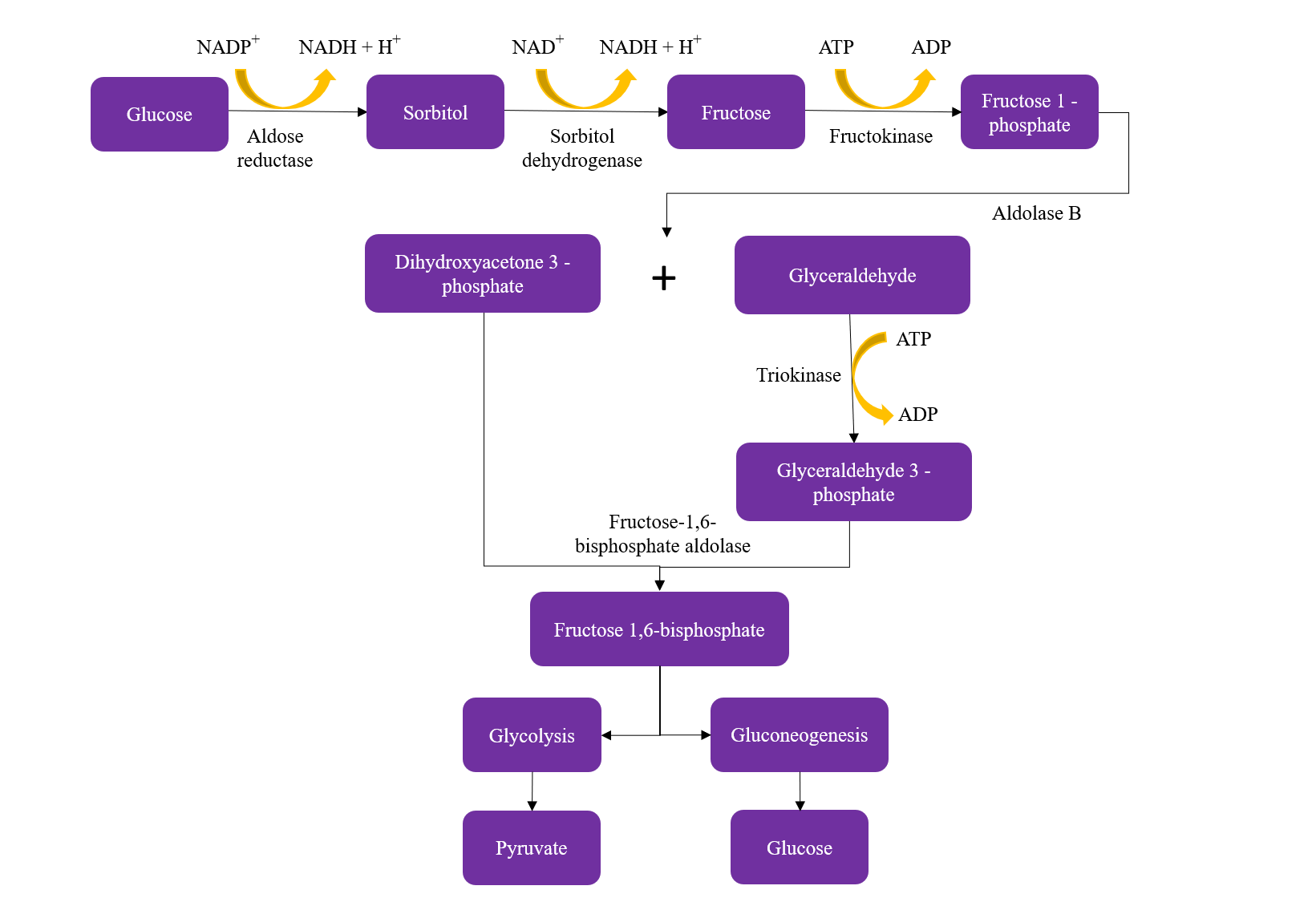[1]
Sloboda DM, Li M, Patel R, Clayton ZE, Yap C, Vickers MH. Early life exposure to fructose and offspring phenotype: implications for long term metabolic homeostasis. Journal of obesity. 2014:2014():203474. doi: 10.1155/2014/203474. Epub 2014 Apr 23
[PubMed PMID: 24864200]
[2]
Sun SZ, Empie MW. Fructose metabolism in humans - what isotopic tracer studies tell us. Nutrition & metabolism. 2012 Oct 2:9(1):89. doi: 10.1186/1743-7075-9-89. Epub 2012 Oct 2
[PubMed PMID: 23031075]
[3]
Theytaz F, de Giorgi S, Hodson L, Stefanoni N, Rey V, Schneiter P, Giusti V, Tappy L. Metabolic fate of fructose ingested with and without glucose in a mixed meal. Nutrients. 2014 Jul 15:6(7):2632-49. doi: 10.3390/nu6072632. Epub 2014 Jul 15
[PubMed PMID: 25029210]
[4]
Herman MA, Samuel VT. The Sweet Path to Metabolic Demise: Fructose and Lipid Synthesis. Trends in endocrinology and metabolism: TEM. 2016 Oct:27(10):719-730. doi: 10.1016/j.tem.2016.06.005. Epub 2016 Jul 4
[PubMed PMID: 27387598]
[5]
Legeza B, Marcolongo P, Gamberucci A, Varga V, Bánhegyi G, Benedetti A, Odermatt A. Fructose, Glucocorticoids and Adipose Tissue: Implications for the Metabolic Syndrome. Nutrients. 2017 Apr 26:9(5):. doi: 10.3390/nu9050426. Epub 2017 Apr 26
[PubMed PMID: 28445389]
[6]
Hannou SA, Haslam DE, McKeown NM, Herman MA. Fructose metabolism and metabolic disease. The Journal of clinical investigation. 2018 Feb 1:128(2):545-555. doi: 10.1172/JCI96702. Epub 2018 Feb 1
[PubMed PMID: 29388924]
[7]
Pollock NK, Bundy V, Kanto W, Davis CL, Bernard PJ, Zhu H, Gutin B, Dong Y. Greater fructose consumption is associated with cardiometabolic risk markers and visceral adiposity in adolescents. The Journal of nutrition. 2012 Feb:142(2):251-7. doi: 10.3945/jn.111.150219. Epub 2011 Dec 21
[PubMed PMID: 22190023]
[8]
Lê KA, Tappy L. Metabolic effects of fructose. Current opinion in clinical nutrition and metabolic care. 2006 Jul:9(4):469-75
[PubMed PMID: 16778579]
Level 3 (low-level) evidence
[9]
Gonzalez JT, Betts JA. Dietary Fructose Metabolism By Splanchnic Organs: Size Matters. Cell metabolism. 2018 Mar 6:27(3):483-485. doi: 10.1016/j.cmet.2018.02.013. Epub
[PubMed PMID: 29514059]
[10]
Ferraris RP, Choe JY, Patel CR. Intestinal Absorption of Fructose. Annual review of nutrition. 2018 Aug 21:38():41-67. doi: 10.1146/annurev-nutr-082117-051707. Epub 2018 May 11
[PubMed PMID: 29751733]
[11]
Varma V, Boros LG, Nolen GT, Chang CW, Wabitsch M, Beger RD, Kaput J. Metabolic fate of fructose in human adipocytes: a targeted (13)C tracer fate association study. Metabolomics : Official journal of the Metabolomic Society. 2015:11(3):529-544
[PubMed PMID: 25972768]
[12]
Akram M, Hamid A. Mini review on fructose metabolism. Obesity research & clinical practice. 2013 Mar-Apr:7(2):e89-e94. doi: 10.1016/j.orcp.2012.11.002. Epub
[PubMed PMID: 24331770]
[13]
Frenette G, Thabet M, Sullivan R. Polyol pathway in human epididymis and semen. Journal of andrology. 2006 Mar-Apr:27(2):233-9
[PubMed PMID: 16278369]
[14]
Tang WH, Martin KA, Hwa J. Aldose reductase, oxidative stress, and diabetic mellitus. Frontiers in pharmacology. 2012:3():87. doi: 10.3389/fphar.2012.00087. Epub 2012 May 9
[PubMed PMID: 22582044]
[15]
Feinman RD, Fine EJ. Fructose in perspective. Nutrition & metabolism. 2013 Jul 1:10(1):45. doi: 10.1186/1743-7075-10-45. Epub 2013 Jul 1
[PubMed PMID: 23815799]
Level 3 (low-level) evidence
[16]
Sievenpiper JL, de Souza RJ, Cozma AI, Chiavaroli L, Ha V, Mirrahimi A. Fructose vs. glucose and metabolism: do the metabolic differences matter? Current opinion in lipidology. 2014 Feb:25(1):8-19. doi: 10.1097/MOL.0000000000000042. Epub
[PubMed PMID: 24370846]
Level 3 (low-level) evidence
[17]
Laughlin MR. Normal roles for dietary fructose in carbohydrate metabolism. Nutrients. 2014 Aug 5:6(8):3117-29. doi: 10.3390/nu6083117. Epub 2014 Aug 5
[PubMed PMID: 25100436]
[18]
Baker K, Sabanegh E Jr. Obstructive azoospermia: reconstructive techniques and results. Clinics (Sao Paulo, Brazil). 2013:68 Suppl 1(Suppl 1):61-73
[PubMed PMID: 23503955]
[19]
Du L, Heaney AP. Regulation of adipose differentiation by fructose and GluT5. Molecular endocrinology (Baltimore, Md.). 2012 Oct:26(10):1773-82
[PubMed PMID: 22827929]
[20]
Fuchs CJ, Gonzalez JT, van Loon LJC. Fructose co-ingestion to increase carbohydrate availability in athletes. The Journal of physiology. 2019 Jul:597(14):3549-3560. doi: 10.1113/JP277116. Epub 2019 Jul 2
[PubMed PMID: 31166604]
[21]
Kim MS, Moon JS, Kim MJ, Seong MW, Park SS, Ko JS. Hereditary Fructose Intolerance Diagnosed in Adulthood. Gut and liver. 2021 Jan 15:15(1):142-145. doi: 10.5009/gnl20189. Epub
[PubMed PMID: 33028743]
[22]
Lu M, Ammar D, Ives H, Albrecht F, Gluck SL. Physical interaction between aldolase and vacuolar H+-ATPase is essential for the assembly and activity of the proton pump. The Journal of biological chemistry. 2007 Aug 24:282(34):24495-503
[PubMed PMID: 17576770]
[23]
Tran C. Inborn Errors of Fructose Metabolism. What Can We Learn from Them? Nutrients. 2017 Apr 3:9(4):. doi: 10.3390/nu9040356. Epub 2017 Apr 3
[PubMed PMID: 28368361]
[24]
Malik VS, Hu FB. Fructose and Cardiometabolic Health: What the Evidence From Sugar-Sweetened Beverages Tells Us. Journal of the American College of Cardiology. 2015 Oct 6:66(14):1615-1624. doi: 10.1016/j.jacc.2015.08.025. Epub
[PubMed PMID: 26429086]
[25]
Gaby AR. Adverse effects of dietary fructose. Alternative medicine review : a journal of clinical therapeutic. 2005 Dec:10(4):294-306
[PubMed PMID: 16366738]

